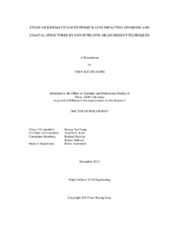| dc.description.abstract | Extreme wave flows associated with a large scale wave breaking during interactions with marine structures or complex coastal geography of is one of the major concerns in a design of coastal and ocean structures. In order to properly understand the impact mechanisms of breaking extreme waves, full field evaluations of impacting multiphase flow velocities should be properly conducted first. In this context, this present dissertation experimentally investigated velocity structures of turbulent, multiphase wave flow velocities during active interactions with various offshore and onshore ocean environments.
First, initial inundation flow structures of tsunami-like long waves interacting with complex coastal topography are experimentally investigated. Turbulent wave surface velocities were effectively measured by introducing a non-intrusive video imagery technique, the “wave front tracing method”. Three distinctive configurations for patch layouts that vary either in characteristic patch diameter (D) or in center-to-center spacing between patches (ΔS) were employed. That is, patch layouts consisted of six (G1) and twelve (G2), “small” circular macro roughness patches of D =1.2 m and six, “large” circular macro roughness patches (G3) of D = 1.7 m were employed, respectively. A patch layout employed for G1 appears to be effective in reducing the u velocities along the centerlines of the reference patch that consistently decreased to 85% of a convergence velocity U = 2m/s and to 45% of U. However, in the channel, u velocities hardly reduced below the convergence velocity. On the other hand, the patch layout G2 is observed as rather effective in uniformly reducing the u velocities alongshore. The hand, the patch layout G3 is observed as effective in suppressing the alongshore variability in flow behind the frontal patches. This may be due to the "holding-up" effects produced by the large patches holding the flow within the patch for a longer duration. Furthermore, such a "holding-up" effect from G3 appears to induce a large inundation depth in the flow along the opening.
Next, green water velocities and dynamic impacts of the extreme ocean waves on a fixed offshore deck structure are investigated. The experiments focused on the impacting waves generated in a large-scale, three-dimensional ocean wave basin. Using the BIV technique, overall flow structures and temporal and spatial distributions of the maximum velocities were successfully evaluated. The most significant spatial variability in mean velocities in the propagating direction was found from the protruding wave front near the center of the deck during early stages of the wave run-up. The maximum front speed of 1.4C was first observed in the center of the deck near y = 0 at a midpoint of the deck (x = 0.5L), where C is the wave phase speed. The flow velocities started decreasing below 1C over all fields once the wave frontal flow passed the rear edge and started leaving the deck. Pressure measurements were also conducted at four different vertical positions on vertical measurement planes at three different locations on the horizontal plane. Most of measured pressures showed impulsive impact patterns with sudden rises of pressure peaks. The highest pressure was observed as 1.56pC^(2) at x = L/2. Correlations between wave kinematic energy and dynamic pressure were examined to determine the impact coefficients ci'. ci' varied within relatively narrow ranges 0.29 ≤ ci' ≤ 1.56. In the present large scale experiments, the impact pressures on the structures are strongly affected by both variability of flow structures and impulsiveness of impacting waves containing considerable air volumes.
Lastly, the study is extended for more violent sloshing wave flows. The study experimentally investigated flow kinematics and impact pressures of a partially filled liquid sloshing flow during the periodic longitudinal motion of a rectangular tank. The horizontal velocities near the free surface reached 1.6C with C being the wave phase speed calculated based on the shallow water assumption. As the tank reached its maximum displacement and about to reverse, the dominant flow changed its direction rapidly to vertical upward after the breaking wave crest impinging on the side wall and forming an up-rushing jet. The vertical velocity of the rising jet reached 3.4C before it impacted the top wall. During the flip-through event as the fast moving wave crest collided with the side wall, the steep wave crest resulted in a focused impact on the side wall at the SWL. The resulting impulsive peak pressure was recorded as about 10ghρ immediately followed by the evident pressure oscillation with a frequency approximately 500 Hz. After the wall impact, the multiphase up-rushing jet shot up and impacted the top wall. The magnitude of the pressure was again about 10ghρ, similar to that recorded by the breaking wave impact on the side wall. Correlating the dynamic impact pressures with the corresponding local maximum flow velocities in the direction normal to the walls was performed by introducing the impact coefficient ic and the modified impact coefficient c'_(i) , defined as p_(max)=c_(i)pV^(2)= c'_(i)pC^(2) with V_(max) being the magnitude of the maximum local velocities. The average values of the modified impact coefficient c′_(i) between the side wall impacts and the top wall impacts were nearly identical, with the average value of c'_(i)=5.2. | en |


